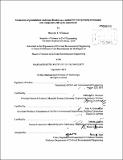| dc.contributor.advisor | Randolph E. Kirchain and John A. Ochsendorf. | en_US |
| dc.contributor.author | Wildnauer, Margaret T. (Margaret Thea) | en_US |
| dc.contributor.other | Massachusetts Institute of Technology. Department of Civil and Environmental Engineering. | en_US |
| dc.date.accessioned | 2013-04-12T19:30:53Z | |
| dc.date.available | 2013-04-12T19:30:53Z | |
| dc.date.copyright | 2012 | en_US |
| dc.date.issued | 2012 | en_US |
| dc.identifier.uri | http://hdl.handle.net/1721.1/78508 | |
| dc.description | Thesis (S.M.)--Massachusetts Institute of Technology, Dept. of Civil and Environmental Engineering, 2012. | en_US |
| dc.description | Cataloged from PDF version of thesis. | en_US |
| dc.description | Includes bibliographical references (p. 97-100). | en_US |
| dc.description.abstract | Life cycle assessments are quickly becoming a crucial method through which the environmental impacts of products or processes are evaluated. A concern with current practice, however, is that the use of deterministic values for inputs and final results only represent a single scenario, not all possible values and outcomes, or even a real-world situation. By incorporating uncertainty, an LCA can account for inherent variation and the use of proxy data, both of which are common occurrences in LCA implementation. In a comparative LCA, this uncertainty allows a decision to be made between alternatives with a certain level of confidence. While uncertainty is necessary for credible results, its implementation can also be time consuming. As LCAs grow more common, methods of streamlining are being explored to reduce both the effort and cost. One such streamlining method that also incorporates uncertainty is probabilistic underspecification. This method evaluates environmental parameters by dividing them into different material and process categories. The lowest level of specification, Level 1, is defined by the type of material or process, such as metal or freight transportation. This category is then subdivided based on different characteristics of the material or process. The highest level of specification, Level 5, consists of the individual database processes used by traditional LCAs. This thesis compares the streamlining method of probabilistic underspecification to the more common method of incorporating uncertainty, termed here as individual probabilistic specification. A case study on alternative pavement designs is used to demonstrate and compare both the methodologies. The effort required for each methodology is compared by the percentage of processes specified at Level 5, which is 100% for individual probabilistic specification, but much less for probabilistic underspecification. The results of the case study showed that as little as 32% or less of the processes need to be specified at Level 5 in order to have the required level of confidence in the decision being made. It can be seen that, as a streamlining method to estimate the results of comparative LCAs, probabilistic underspecification is a viable option. | en_US |
| dc.description.statementofresponsibility | by Margaret T. Wildnauer. | en_US |
| dc.format.extent | 119 p. | en_US |
| dc.language.iso | eng | en_US |
| dc.publisher | Massachusetts Institute of Technology | en_US |
| dc.rights | M.I.T. theses are protected by
copyright. They may be viewed from this source for any purpose, but
reproduction or distribution in any format is prohibited without written
permission. See provided URL for inquiries about permission. | en_US |
| dc.rights.uri | http://dspace.mit.edu/handle/1721.1/7582 | en_US |
| dc.subject | Civil and Environmental Engineering. | en_US |
| dc.title | Evaluation of probabilistic underspecification as a method for incorporating uncertainty into comparative life cycle assessments | en_US |
| dc.type | Thesis | en_US |
| dc.description.degree | S.M. | en_US |
| dc.contributor.department | Massachusetts Institute of Technology. Department of Civil and Environmental Engineering | |
| dc.identifier.oclc | 836792554 | en_US |
